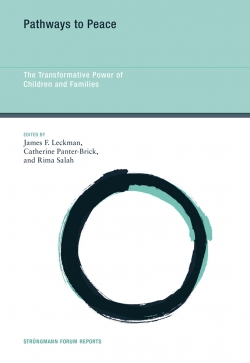Mental Health and Development among Children Living in Violent Conditions: Underlying Processes for Promoting Peace
Mental Health and Development among Children Living in Violent Conditions: Underlying Processes for Promoting Peace
Chapter 12 author: Raifa-Leena Punamaki
Introduction
Links between collective and interpersonal violence often result in socioeconomic pressures and political insecurity, increasing the risk for domestic violence in war zones. Processes that foster resilience include creative narratives that provide cultural meaning to distressing experiences, supportive social relations, and functional cognitive and emotional coping strategies.
Nature of Violence and Child Development
In both domestic and military violence, children try to make sense of experiences by attempting to mitigate harm and take responsibility for solving the problem. It is believed that violence through intimate relations is to be considered more traumatic than war related violence or natural disasters. The nature of violence evokes specific responses and coping strategies. For example, in many Palestinian families, exposure to childhood maltreatment is associated with decreased social support, while military violence results in increased support. This can be explained through cultural values of heroism and collective appreciation of national sacrifice, as well as universal shame related to family violence. Exposure to interpersonal violence shatters core health while still maintaining the belief that other humans are benevolent, fair, and predictable. Children appraise and attribute their violent experiences in the context of social and family rules, some of which are found throughout the world and others that are culturally bound. While the impact of violence on social development can result in aggression, withdrawal, and marginalization, it can also have a positive impact on the children: aiding their capacity to grow up as resilient and justice-minded, peacebuilding citizens.
Underlying Mechanisms for Negative and Positive Outcomes
It is likely to assume that war can increase positive peer relationships that create feelings of safety and togetherness in adults. Children, however, are more likely to deteriorate rather than improve peer and friendship relations because of the changed behavior of children, and their fears and prejudices of their peers. They often withdraw from intimate contacts because some experiences have been too painful or shameful to share with peers. Children also endure intrusive and uncontrollable memories and often feel a sense of judgement from peers due to their vigilance for danger. Sibling relations can have positive or negative outcomes. Stressful civilian events such as divorce and unemployment can improve sibling relations by increasing intimacy and decreasing rivalry and war violence, atrocities, losses can increase rivalry and conflict. The healing power of sufficient and adequate social support lies in the creation of shared meanings and narratives, cathartic experience of expressing painful emotions, and the act of affiliating with others. The purpose of interventions that help violence-affected youth is to encourage social sharing and disclosure of emotions, and to train cohesive group processes, such as empathy and listening skills. The goal of psychosocial interventions is to support and improve parenting as a natural healing resource among war-affected children by creating a safe space, encouraging family narratives to be shared, and enriching child and parent communication.
Cognitive Processes of Appraisal, Memory, and Symbols
Cognitive changes can make children more vulnerable while helping them rebuild their shattered lives by seeking creative resolutions. Community acceptance, cultural rituals, and religious functions act as protective and healing shields for the well-being and cognitive development among war-affected children. Traumatic experiences negatively impact autobiographical, episodic, and verbal memory in children, hindering their recovery. In addition, any upsetting recollections of a child’s existing sensory, cognitive, and emotional schema, can prevent them from being integrated into a child’s personal history which can result in fragments of the traumatic scenes intruding involuntarily into the child’s mind. The symbolic processes of playing, dreaming, and fantasizing provide protective and healing elements, but can also be negatively impacted by violence and trauma. Psychosocial interventions incorporate therapeutic elements that counter these traumatic impacts and provide violence-affected children with access to healing.
Neurocognitive Processes
Violent experiences impact brain development through overburdening neurobiological stress responses and the serotonin system. The maltreatment risk for functional and anatomical changes in prefrontal cortex includes the ability to be active in planning, decision making, working memory, and inhibitory processes. It also plays role in fear conditioning, emotion regulation, impulse control, and shifting attention. Adults who were subjected to maltreatment have a smaller volume of the hippocampus, and the combination of elevated stress hormones and PTSD symptoms can predict a reduction of hippocampal volume. This provides a neurobiological basis for intrusive memories, uncontrollable emotions, and disintegrated mental states among victims of violence.
Interventions and the Promotion of Peace among Children Affected by Violence
Cognitive behavioral therapy is effective for both war-affected and maltreated children. Cognitive behavior therapy includes teaching emotions modulation, coping strategies, and integrating cognitive and affective domains. Narrating and sharing traumatic experiences in safe, supportive settings helps children organize fragmented sensory and emotional memories. For war affected children, interventions focus on reduction of mood and anxiety disorders and conduct problems, but call to include access to optimal social and cultural resources. Psychosocial interventions contribute to peacebuilding in violence-affected children through symptom focused efforts to alleviate psychosocial distress, a resilience enhancing approach that focuses on the importance of positive and compensatory experiences, and lastly, by integrating mental health and peace promotion as an integral part in group and individual treatments.
Sociopolitical Frames to Facilitate Peacebuilding
Addressing the traumatic and violent experiences that result in compromised developmental potential are only part of the issue. Societal preconditions must also be involved especially in issues such as the cycle of revenge, heated by collective and individual memories of wrongdoing, injustice, and pain. Forgiveness and peacebuilding must also be addressed at both the basic psychosocial level of individual as well as at the cultural processes level of society.
JOIN THE CONVERSATION
For breaking news and to stay connected, follow us on social media. Sign up to get our E-News delivered straight to your inbox.

